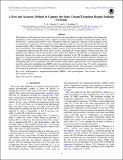Files in this item
A fast and accurate method to capture the solar corona/transition region enthalpy exchange
Item metadata
| dc.contributor.author | Johnston, C. D. | |
| dc.contributor.author | Bradshaw, S. J. | |
| dc.date.accessioned | 2019-04-02T09:30:49Z | |
| dc.date.available | 2019-04-02T09:30:49Z | |
| dc.date.issued | 2019-03-15 | |
| dc.identifier | 258429968 | |
| dc.identifier | 8713b4e5-785e-492b-ab5f-7581529e1da0 | |
| dc.identifier | 85063541487 | |
| dc.identifier | 000461518800004 | |
| dc.identifier.citation | Johnston , C D & Bradshaw , S J 2019 , ' A fast and accurate method to capture the solar corona/transition region enthalpy exchange ' , Astrophysical Journal Letters , vol. 873 , no. 2 , L22 . https://doi.org/10.3847/2041-8213/ab0c1f | en |
| dc.identifier.issn | 2041-8213 | |
| dc.identifier.other | RIS: urn:F7E27D8D8B8723040C3E9CABD5151697 | |
| dc.identifier.other | ORCID: /0000-0003-4023-9887/work/56184305 | |
| dc.identifier.uri | https://hdl.handle.net/10023/17417 | |
| dc.description | This research has received funding from the European Research Council (ERC) under the European Union’s Horizon 2020 research and innovation program (grant agreement No. 647214). S.J.B. is grateful to the National Science Foundation for supporting this work through CAREER award AGS-1450230. C.D.J. acknowledges support from the International Space Science Institute (ISSI), Bern, Switzerland to the International Team 401 “Observed Multi-Scale Variability of Coronal Loops as a Probe of Coronal Heating.” | en |
| dc.description.abstract | The brightness of the emission from coronal loops in the solar atmosphere is strongly dependent on the temperature and density of the confined plasma. After a release of energy, these loops undergo a heating and upflow phase, followed by a cooling and downflow cycle. Throughout, there are significant variations in the properties of the coronal plasma. In particular, the increased coronal temperature leads to an excess downward heat flux that the transition region (TR) is unable to radiate. This generates an enthalpy flux from the TR to the corona, increasing the coronal density. The enthalpy exchange is highly sensitive to the TR resolution in numerical simulations. With a numerically underresolved TR, major errors occur in simulating the coronal density evolution and, thus, the predicted loop emission. This Letter presents a new method that addresses the difficulty of obtaining the correct interaction between the corona and corona/chromosphere interface. In the TR, an adaptive thermal conduction approach is used that broadens any unresolved parts of the atmosphere. We show that this approach, referred to as TRAC, successfully removes the influence of numerical resolution on the coronal density response to heating while maintaining high levels of agreement with fully resolved models. When employed with coarse spatial resolutions, typically achieved in multidimensional MHD codes, the peak density errors are less than 3% and the computation time is three orders of magnitude faster than fully resolved field-aligned models. The advantages of using TRAC in field-aligned hydrodynamic and multidimensional magnetohydrodynamic simulations are discussed. | |
| dc.format.extent | 3187817 | |
| dc.language.iso | eng | |
| dc.relation.ispartof | Astrophysical Journal Letters | en |
| dc.subject | Hydrodynamics | en |
| dc.subject | Magnetohydrodynamics (MHD) | en |
| dc.subject | Sun: chromosphere | en |
| dc.subject | Sun: corona | en |
| dc.subject | Sun: flares | en |
| dc.subject | Sun: transition region | en |
| dc.subject | QB Astronomy | en |
| dc.subject | T-NDAS | en |
| dc.subject.lcc | QB | en |
| dc.title | A fast and accurate method to capture the solar corona/transition region enthalpy exchange | en |
| dc.type | Journal article | en |
| dc.contributor.sponsor | European Research Council | en |
| dc.contributor.institution | University of St Andrews. Applied Mathematics | en |
| dc.identifier.doi | 10.3847/2041-8213/ab0c1f | |
| dc.description.status | Peer reviewed | en |
| dc.identifier.url | https://arxiv.org/abs/1903.01132 | en |
| dc.identifier.grantnumber | 647214 | en |
This item appears in the following Collection(s)
Items in the St Andrews Research Repository are protected by copyright, with all rights reserved, unless otherwise indicated.

